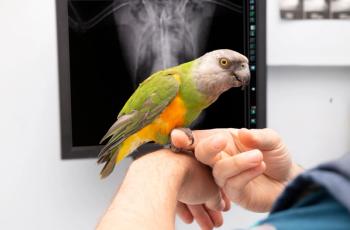
Finding work-life harmony

What are you risking when you don’t set healthy boundaries in the workplace?
This article was updated October 20, 2022.
As the conversation surrounding wellness and self-care in the veterinary industry continues to grow, Shawn McVey, MS, MSW, introduced the concept of physiological fatigue to attendees at the 2022 Atlantic Coast Veterinary Conference in Atlantic City, New Jersey. “I think a lot of what we label burnout and compassion fatigue is really psychological fatigue brought on by the inability to manage ourselves and those around us,” he said.
McVey, the chief culture officer at Veterinary Growth Partners in Austin, Texas, further explained: “To say ‘I have compassion fatigue’ means you have given so much love and compassion that you have nothing left to give. When you give without being able to refill yourself, you risk burning out.”
Veterinary professionals rarely consider how to “refill” themselves before reaching the point of mental and emotional exhaustion, he noted. “Part of refilling yourself is having boundaries,” he said.
Have you established boundaries in your hospital?
In almost every hospital, there is 1 person doing the work of 3, and 2 people getting by at 50%, McVey explained. This stems from a lack of boundaries or awareness of boundaries because no one feels comfortable expressing their feelings about the situation. “Can you think of people in your hospital that this describes,” he asked attendees.
The ability to recognize and establish boundaries is also linked firmly to emotional intelligence (EQ). Therefore, a lack of boundaries is a symptom of poor EQ.
Health implications of poor EQ and wellbeing
It is hard to ascertain, medically, what diseases and ailments result from a lack of boundaries, poor work-life balance, and mounting stress versus what natural deteriorations may occur to a person’s health. Symptoms may include increased risk of heart disease, stroke, and type 2 diabetes, as well as frequent headaches, high blood pressure, and insomnia.
“A lot of our illnesses today are caused by stress. The first way you receive stress is by not taking care of your boundaries,” McVey said.
The difference between work-life balance and harmony
Work-life balance describes a state of equilibrium between your work and your personal life, where each remains in separate silos. When work-life balance is the expectation, we’re setting ourselves up for failure, McVey warned.
The ideal no longer works in conjunction with present-day technology and constant connectedness. Veterinary professionals frequently have on-call hours and shifts that run long. Added to that is the ease with which coworkers can communicate via call or text with work-related issues. During a slow moment outside the practice, a veterinary professional may instinctively open an email only to be met with a summary from a meeting, a process update, someone scheduling a call, a resignation letter, or a client complaint. None of this aligns with a work-life balance paradigm. And without proper boundaries, the issue is 10-fold. When work consistently bleeds into your personal life, it becomes excruciatingly overwhelming, McVey noted.
The expectations for what we truly want our work-life relationship to look like should be reconsidered, McVey continued. This is where the concept of harmony comes into play.
Harmony is the perfect analogy for work and life because it recognizes that the multiple notes of our work and lives happen simultaneously, he said. It is up to the individual to create a pleasing harmony, and it can be deeply personal. Changing the expectation from balance to harmony may be a better way to manage expectations and set feasible boundaries, McVey reiterated.
Symptoms of unhealthy boundaries
Set Boundaries Workbook: Practical Exercises for Understanding Your Needs and Setting Healthy Limits is a reputable resource for setting, communicating, and enforcing healthy boundaries. According to the author, Nedra Glover Tawwab, MSW, LCSW, several symptoms indicate unhealthy boundaries in one’s career, such as the following:
- Always the helper, never being helped
- Burnout
- Feeling overwhelmed
- Inability to say ‘no’
- Loaning money or possessions
- Neglecting self-care
- Resentment
- Unable to ask for help
According to McVey, there is no shame in admitting that you are combatting some implications of unhealthy boundaries. Oftentimes, being agreeable to requests stems from a need for approval, acceptance, or affirmation. It is common for people to overcommit to avoid negative emotions, rejection, pushback, loss of opportunities, friction, and feeling unneeded, McVey said.
In veterinary medicine, the sheer nature of needing to be accessible to patients results in a myriad of violated boundaries. “Literally, the boundary of I need to eat is violated,” McVey said. “The boundary of I need to sleep is violated. The boundary of I would like more than 18 inches of space around me for more than 5 minutes is often violated.”
Another common symptom of an unhealthy boundary is preferring to work entirely on your own. “That is not really possible in a veterinary environment,” he added. “Everything requires a hand-off in a hospital. There are very few products we give to clients that do not require at least one or two more staff to be involved.”
In today’s private practice market, it is almost impossible to function entirely on your own, he pointed out.
Steps to implement boundaries
“Ultimately, boundaries come from your values,” McVey explained to attendees. We can all start with animals being a value, he continued. “From there, do you value your health, do you value your society, do you value your physical self, do you value making money or making an impact on your community?”
There are countless ways to describe individual values. “Your boundary becomes: what are the things that will support those values? You start there.”
McVey encouraged the audience to consider how they can take actionable steps to create healthier boundaries, simultaneously putting their well-being at the forefront. Some of the methods he suggested include:
- Delegate
- Create a support system
- Design protocols
- Empower your team
- Manage time more wisely
- Optimize technology
- Plan meals
- Practice self-care
- Take a break
- Use PTO
In a veterinary hospital, there are common boundaries to stand firm on related to operations. Staffing ratios, time limits on appointments, delivery of medications, and how inventory should be counted are some examples. “Lack of boundary care is a lack of self-care,” McVey declared.
Master the art of setting boundaries
McVey is dedicated to helping others succeed in their quests to set boundaries and improve wellbeing, he said. These are some of his quick tips:
- Ask questions to determine priorities
- Avoid saying ‘yes’ or ‘no’ in the moment
- Communicate your boundaries clearly
- Empower your team to problem-solve for themselves
- Keep boundaries simple
- Offer an alternative
- Review what you have already committed to
Veterinary teams that have implemented strong boundaries report an increase in productivity, motivation, and satisfaction, as well as improved loyalty and commitment. Staff report feeling happier and less stressed, having a positive view of their employer, and decreased absenteeism, McVey said in his closing remarks.
Reference
McVey S. Boundaries at work—setting healthy limits. Presented at: Atlantic Coast Veterinary Conference, October 10-12, 2022; Atlantic City, New Jersey. Accessed October 12, 2022.
Newsletter
From exam room tips to practice management insights, get trusted veterinary news delivered straight to your inbox—subscribe to dvm360.




